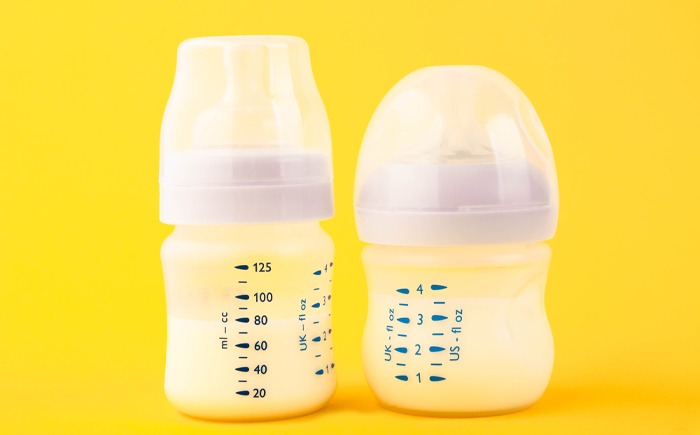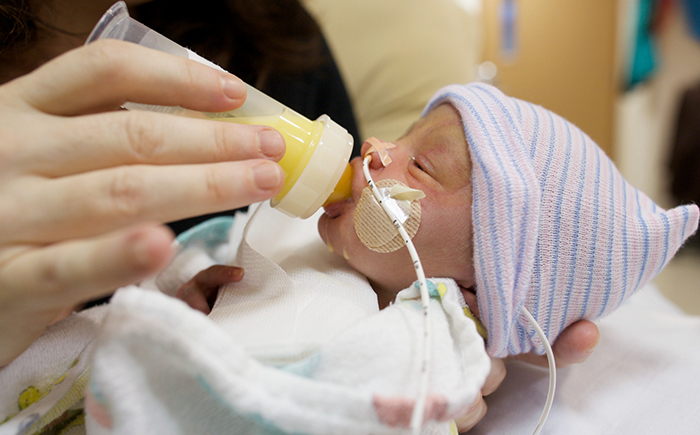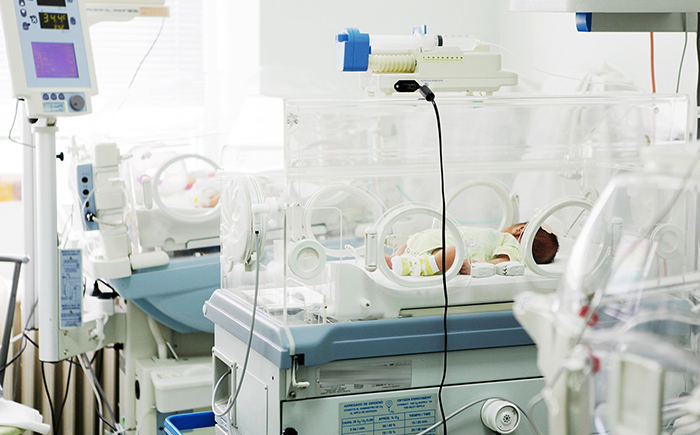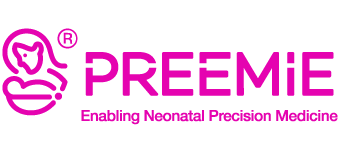Is targeted fortification cost-beneficial?

Several studies have been executed so far to assess the benefits of the targeted fortification approach when compared to the standard approach currently adopted (see Fabrizio 2020 for a recent review). These studies allowed us to appreciate the potentiality of targeted fortification in improving the clinical outcomes for preterm infants.
While standard fortification poses the infants at risk of not getting the recommended intake, due to the lack of knowledge of the actual macronutrient content in the administered human milk, the targeted approach allows neonatologists to fortify the milk based on the actual milk content, which implies that the feeding given is tailored to the specific infants’ need.
Amongst the most promising results evidenced so far, infants fed with the targeted approach experience higher macronutrient intakes, higher weight gain and in general improved growth velocities for what concerns weight, length, and head circumference. They also show higher fat-free mass and less frequent feeding intolerance. Such results are due to a limited variation of macronutrient intake, which allows for a more balanced and constant diet. Infants get similar composition every day, avoiding the administration of lots of proteins or fat on one day, and less proteins or fat the other day, thus posing less stress on their premature gut and metabolism. Such outcomes have been recently linked to a reduced neonatal morbidity, in particular for what concerns the occurrence of NEC, sepsis and bronchopulmonary dysplasia (see Rochow 2020 and Sánchez Luna 2020). There is clearly the need to confirm those results, and above all quantify them, through specifically designed interventional trials. Meanwhile it’s not surprising that an increasing number of hospitals and neonatologists is implementing the targeted approach for managing the feeding of preterm infants.
But there is also the other side of the coin: compared to the standard approach, targeted fortification is more time-consuming, requires the purchase and maintenance of specific equipment for analysing human milk, and also trained staff for both operating the device and for calculating the fortification needed. Rochow 2015 estimated an average of 10-15 minutes per patient per day for applying this approach, which clearly raises the overall operational costs of the nursery.
In order to contain such costs and make the targeted approach sustainable in all nurseries, studies have been performed to assess the most cost-effective frequency of human milk analysis, trying to minimize as much as possible the macronutrient variation in infants’ feeding from day to day, but also reducing the workload for operators. For instance, Rochow 2015 suggested to perform human milk analysis “at least twice a week” as an optimal trade-off.
So, if we consider both benefits and costs, the big question is: is the targeted approach really cost-beneficial? To give an accurate answer, specific health economics studies are needed, where costs for implementation and maintenance of such an approach are compared to economic quantification of evidence-based benefits (for instance, savings generated by reducing the length of stay or key diseases, such as NEC).
Far from being an exhaustive article on this topic, we want here just to highlight a few available data aimed to provide a sense of the potential savings that could be generated by applying the targeted approach.

- Reduction of length of stay. Several studies mentioned this potential benefit (see Rochow 2015), even if this has not been confirmed yet in the trials performed so far. The cost per hospitalization day varies from Country to Country, and even amongst hospitals in the same area. We take as a reference two studies performed by Johnson (2013 and 2015), where the average cost per hospitalization day of a VLBW infant was estimated respectively at $1,052 and $1,874. A hospital serving an average of 100 infants per year would therefore get significant savings even with just a 1-day reduction of the length of stay per infant (between $100,000 and $180,000).、

- Reduction of parenteral nutrition. A more balanced diet in line with the targeted requirements may help in a faster switch from parenteral to enteral nutrition. Savings could be quite significant, if we consider that around $1,436 is spent daily per patient receiving parenteral feeding (Edwards 2012). In the use case of the previous point, savings per year could therefore reach around $143,000 in case of just 1-day reduction of parenteral feeding per infant.

- Reduction of diseases during hospitalization. Since infants are fed with basically the same macronutrient composition over time, their gut works under more steady condition, and this is considered a factor for reducing the occurrence of specific diseases. This is going to be studied in upcoming clinical trials (see Seliga-Siwecka 2020), while other studies reported a reduction of specific diseases (see Sánchez Luna 2020). Let’s consider three diseases whose reduction has been mentioned in such studies: NEC, sepsis and bronchopulmonary dysplasia. The costs for those diseases have been reported in various studies. In Johnson 2015 reported an average total NICU hospitalization cost (in 2012 dollars) of $180,163 per infants with NEC and $134,494 for infants without NEC. NEC was associated with a marginal increase in costs of $43,818. Johnson 2013 reported that the presence of bronchopulmonary dysplasia was associated with a $31,565 increase in direct costs, and late-onset sepsis with a $10,055 increase. Any assumptions on the reduction rate would be completely arbitrary at this point, but imagine that just one case of each disease is avoided every year in a hospital. This will make savings up to more than $85,000 every year.

- Long-term economic benefits. Savings in this area are clearly the most complex to be demonstrated and quantified, since they require the quantification of savings on clinical complications after hospitalization and on potentially life-long morbidities. One focus of the analysis could be related to the long-term benefits (and related savings) due to avoiding under- and over-nourishment caused by the standard approach. Another example is related to avoiding neurological impairment, due to optimal growth and to the reduction of infants’ morbidities during the hospitalization period. Let’s make a some reasonings related to the latter point.
A key point is related to the “quality” of the weight gained during the hospitalization period. Parat 2020 showed that “targeted fortification of milk can influence the quality of weight gain through promoting fat-free mass in infants”, and early gain in fat-free mass has been demonstrated to generate positive long-term effects, unlike fat mass. Ramel 2016 demonstrated the association of fat-free mass at discharge with improved neurodevelopment in VLBW preterm infant at 12 months, while Scheurer 2018 showed that high percentage of fat mass is associated with lower-working memory performance in pre-school age (4 years). Another study (Frondas-Chauty 2018) demonstrated that a deficit of fat-free mass at discharge is associated with neurological impairment at two years of age.
Neurodevelopment impairment has also been demonstrated to more likely occur in infants who had NEC or sepsis (diseases that the targeted approach could reduce) than in preterm infants without such morbidities (see Rees 2006 and Cai 2019). Conditions such as cerebral palsy, vision impairment or hearing impairment could be reduced thanks to the optimal growth promoted through targeted fortification, or indirectly by reducing the occurrence of diseases that make such impairment more likely in a later age. And their costs are not negligible. Honeycutt 2015 showed that lifetime costs per person for cerebral palsy are around $804,000 (in US$ 2000), for hearing loss at $325,000 and for vision impairment at $469,000. This gives us a sense of how large the life-long savings could be both for the society and for the patients.
So, a lot of work is still needed to precisely quantify the economic benefits of the targeted approach through evidence-based studies, but the more our knowledge advances in this field, the more targeted fortification seems to provide promising results.
We therefore want to conclude this blog by mentioning Sánchez Luna 2020. The study reports the benefits coming from the establishment of a personalized nutrition unit (PNU), based on a smart management of mother’s milk and the application of targeted fortification. This approach led to “a significant reduction of NEC in preterm infants of < 32 weeks of gestation, from 10.9% (12/110) to 2.4% (2/84), and late-onset sepsis from 14.7 cases/1,000 days of central lines to 9.5 cases/1,000 days of central lines, with a shorter use of central venous catheters for parenteral nutrition and a better growth during hospitalization”.
We are firmly convinced that similar studies and their promising results will multiply in the near-future, not only evidencing the unique clinical benefits that the targeted approach can guarantee to preterm babies, but also demonstrating that the approach is sustainable and economically beneficial in both the short and long term. The path seems really to be market out, and Preemie is proud to give its contribution to this radical change.
REFERENCES
Fabrizio 2020 – Fabrizio V, Trzaski JM, Brownell EA, Esposito P, Lainwala S, Lussier MM, Hagadorn JI. Individualized versus standard diet fortification for growth and development in preterm infants receiving human milk. Cochrane Database of Systematic Reviews 2020, Issue 11. Art. No.: CD013465. DOI: 10.1002/14651858.CD013465.pub2.
Rochow 2020 – Niels Rochow, Gerhard Fusch, Anaam Ali, Akshdeep Bhatia, Hon Yiu So, Renata Iskander, Lorraine Chessell, Salhab el Helou, Christoph Fusch. Individualized target fortification of breast milk with protein, carbohydrates, and fat for preterm infants: A double-blind randomized controlled trial. Published by Elsevier Ltd. 2020, https://doi.org/10.1016/j.clnu.2020.04.031.
Sánchez Luna 2020 – Manuel Sánchez Luna, Sylvia Caballero Martin, Carmen Sánchez Gómez-de-Orgaz. Human milk bank and personalized nutrition in the NICU: a narrative review, European Journal of Pediatrics, 2020, https://doi.org/10.1007/s00431-020-03887-y
Rochow 2015 – Niels Rochow, Gerhard Fusch, Bianca Zapanta, Anaam Ali, Sandip Barui and Christoph Fusch. Target Fortification of Breast Milk: How Often Should Milk Analysis Be Done?, Nutrients 2015, 7, 2297-2310; doi:10.3390/nu7042297
Johnson 2013 – Tricia J. Johnson, Aloka L. Patel, Briana J. Jegier, Janet L. Engstrom, and Paula P. Meier. Cost of Morbidities in Very Low Birth Weight Infants. THE JOURNAL OF PEDIATRICS, Vol. 162, No. 2, 2012. DOI:https://doi.org/10.1016/j.jpeds.2012.07.013
Johnson 2015 – Tricia J. Johnson, Aloka L. Patel, Harold R. Bigger, Janet L. Engstrom, and Paula P. Meier. Cost Savings of Human Milk as a Strategy to Reduce the Incidence of Necrotizing Enterocolitis in Very Low Birth Weight Infants. Neonatology. 2015 ; 107(4): 271–276. doi:10.1159/000370058
Edwards 2012 – Taryn M. Edwards, Diane L. Spatz. Making the Case for Using Donor Human Milk in Vulnerable Infants. Adv Neonatal Care. 2012 Oct;12(5):273-8; quiz 279-80. doi: 10.1097/ANC.0b013e31825eb094.
Seliga-Siwecka 2020 – Joanna Seliga-Siwecka, Anna Chmielewska and Katarzyna Jasińska. Effect of targeted vs standard fortification of breast milk on growth and development of preterm infants (≤ 32 weeks): study protocol for a randomized controlled trial. Trials (2020) 21:946 https://doi.org/10.1186/s13063-020-04841-x
Parat 2020 – Sumesh Parat, Praneeta Raza, May Kamleh, Dennis Super and Sharon Groh-Wargo. Targeted Breast Milk Fortification for Very Low Birth Weight (VLBW) Infants: Nutritional Intake, Growth Outcome and Body Composition. Nutrients. 2020 Apr 21;12(4):1156. doi: 10.3390/nu12041156.
Ramel 2016 – Sara E. Ramel, Heather L. Gray, Ellen Christiansen, Christopher Boys, Michael K. Georgieff, and Ellen W. Demerath. Greater Early Gains in Fat-Free Mass, but Not Fat Mass, Are Associated with Improved Neurodevelopment at 1 Year Corrected Age for Prematurity in Very Low Birth Weight Preterm Infants. J Pediatr. 2016 Jun;173:108-15. doi: 10.1016/j.jpeds.2016.03.003. Epub 2016 Apr 4.
Scheurer 2018 – Johannah M. Scheurer, Lei Zhang, Erin Plummer, Solveig Hultgren, Ellen W. Demerath, Sara E. Ramel. Body Composition Changes from Infancy to 4 Years and Associations with Early Childhood Cognition in Preterm and Full-Term Children. Neonatology 2018;114:169–176 DOI: 10.1159/000487915
Frondas-Chauty 2018 – Anne Frondas-Chauty, Laure Simon, Cyril Flamant, Matthieu Hanf, Dominique Darmaun, and Jean-Christophe Rozé. Deficit of Fat Free Mass in Very Preterm Infants at Discharge is Associated with Neurological Impairment at Age 2 Years. J Pediatr. 2018 May;196:301-304. doi: 10.1016/j.jpeds.2017.12.017.
Rees 2006 – Clare M Rees, Agostino Pierro, Simon Eaton. Neurodevelopmental outcomes of neonates with medically and surgically treated necrotizing enterocolitis. Arch Dis Child Fetal Neonatal Ed 2007;92:F193–F198. doi: 10.1136/adc.2006.099929
Cai 2019 – Shirley Cai, Deanne K. Thompson, Peter J. Anderson, and Joseph Yuan-Mou Yang. Short- and Long-Term Neurodevelopmental Outcomes of Very Preterm Infants with Neonatal Sepsis: A Systematic Review and Meta-Analysis. Children (Basel). 2019 Dec; 6(12): 131. doi: 10.3390/children6120131
Honeycutt 2015 – Amanda A Honeycutt, Scott D Grosse, Laura J Dunlap, Diana E Schendel, Hong Chen, Edward Brann, Ghada al Homsi. “ECONOMIC COSTS OF MENTAL RETARDATION, CEREBRAL PALSY, HEARING LOSS, AND VISION IMPAIRMENT” In Using Survey Data to Study Disability: Results from the National Health Survey on Disability. Published online: 10 Mar 2015; 207-228.

